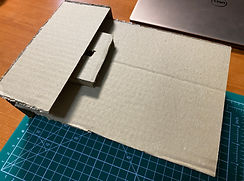

This is what Bob needs!



Durable, food-safe HDPE plastic.
Walls can be attached on both sides.
Grippy rubber.
No more sliding board.

All sides come off, easily.
Introducing Galileo...

Walls on 3 sides to catch juice and flying pieces.
Want to know more?
How to use 'Galileo'?

Put all sides up to catch flying carrot bits or squirting tomato juice.

Take off one side if you need more room to work.

Take off all sides to clean. Stack all parts together to store.

Design a way to prevent chopped food from flying off the chopping board.
JOURNEY TO THE IDEA
The kitchen is a messy place, and everyone knows it. So what do you expect when you gather a group of food-loving MechEng students to make home life easier? – They create a kitchen gadget, of course. We identified several causes of mess, and from there we identified 3 areas for further research.
-
Oil splattering from pots and pans
-
Food jumping off the board when chopping
-
Liquid, mostly porridge, boiling over in the microwave
Based on the number of existing products in the market and how achievable our designs were, we decided that ‘Food Jumping’ would be the issue to take forward to the next stage.

Exisiting products:

Multi-functional Cutting Tool

Vegetables Slicer

Salad Cutter
Existing cutting tools are mainly designed for specific food, we aim to design a product for general use.
Now that we knew what issue we wanted to tackle and did a bit more research, we found three routes to fixing the problem.
-
Make sure the chef always has a sharp knife.
-
Make sure the chef uses a good chopping technique.
-
Have something to catch the bits making the jump from board to the floor.
Guided by these three routes, each of us came up with three designs. We did a morphological chart analysis on all the ideas using design achievability, originality, and a product-traits ranking, indicated by our customer survey, as criteria, and finally settled on what we have now.






PROTOTYPING
After identifying the key aspects of the final design, we began testing our concepts for each aspect. The results helped designing the final product.
Aspect to test
Pictures
Method
Results
Aspect to test
Pictures
Method
Results
Height of guard


-
Cut tomatoes/oranges
-
Record location of splashes
-
Splashes along the short edge are higher than the long edge (200mm vs 150mm)
-
This determines the minimum height of the final design
Design of guard




-
Tested different designs
-
compared their effectiveness of catching food
-
The design with 3 sides (1 long + 2 short edges) is overall the best
-
But food could jump off towards the user as the side is not guarded
Adjustable size

-
Designed a mechanism to adjust the length of the guard
-
Due to the complication of designing a universal guard for all chopping boards, we will design for one size first.
Prevent slipperiness

-
Tested different materials to be put underneath the chopping board to reduce slipping
-
Materials included bicycle wheel, damped cloth, and damped paper towel
-
The inner tube of the bicycle wheel is most effective in reducing slipping
-
The final design may contain similar materials for example rubber

INCLUSIVE DESIGN
Bob has a high risk job, wielding a knife all day. We want to make sure if anything was to ever happen to Bob, 'Galileo' would still be able to help him in his kitchen adventure.
We interviewed the lovely Alexis from Youtube, who hosts a cooking channel called 'Stump Kitchen', to make sure our product will not cause extra difficulty for people with physical disabilities. Even better, if our product can actually help them get into cooking. Head over to her channel if you feel like being inspired today.
One big change we made after the chat was to redesign the board-side connection, so the sides can be easily taken off with only one hand, giving people with limb difference wide access to the chopping board.


Old Design

New Design
MANUFACTURING

main chopping board


long-edge side
Injection moulding
simple shapes

rubber strip
Moulded around main chopping board
short-edge side x 2
good resistance to alcohols, acids, and alkalis
good toughness
High-Density Polyethylene (HDPE)
good durability
safe for food contact
TESTING
A half-size model of the final design was prototyped using 3D printing in order to test the key aspects of the product. As the ability to stop food from flying off has been tested in the prototyping section, this model focuses on other key aspects.
The prototype was tested against the three following criteria. The testing results and user feedback are only obtained from one of our team members due to difficulties in transporting the prototype.

Ease of cleaning and storing

Ability to prevent slipping

Ease of assembly and disassembly

- the grooves for the sides are easy to clean
- the rubber can also be cleaned easily with water
- can be stored easily when disassembled due to flat design
- the rubber strip is sufficient to prevent slipping
- the sides can be attached and removed using one hand only
- one of the sides is wobbly which could be due to 3D printing, the tolerances will be focused on during manufacturing


